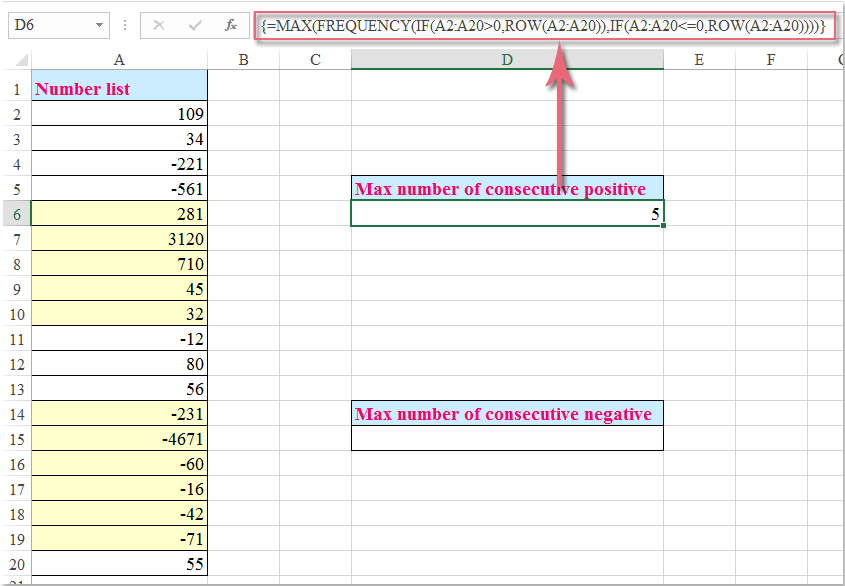¿Cómo contar el número máximo de números positivos / negativos consecutivos en Excel?
Si tienes una lista de datos que mezcla números positivos y negativos, y ahora quieres contar el número máximo de números positivos y negativos consecutivos como se muestra en la siguiente captura de pantalla, ¿cómo podrías manejar esta tarea en Excel?

Cuenta el número máximo de números positivos y negativos consecutivos con fórmulas matriciales
Cuenta el número máximo de números positivos y negativos consecutivos con fórmulas matriciales
Para obtener el número máximo de números positivos y negativos consecutivos, por favor aplica las siguientes fórmulas matriciales:
Cuenta el número máximo de números positivos consecutivos:
Introduce esta fórmula en una celda donde quieras obtener el resultado:
=MAX(FREQUENCY(IF(A2:A20>0,ROW(A2:A20)),IF(A2:A20<=0,ROW(A2:A20)))), y luego presiona simultáneamente las teclas Ctrl + Shift + Enter, y obtendrás el resultado correcto que necesitas, ver captura de pantalla:

Cuenta el número máximo de números negativos consecutivos:
Introduce esta fórmula en una celda donde quieras obtener el resultado:
=MAX(FREQUENCY(IF(A2:A20<0,ROW(A2:A20)),IF(A2:A20>=0,ROW(A2:A20)))), y luego presiona simultáneamente las teclas Ctrl + Shift + Enter, y obtendrás el resultado que necesitas, ver captura de pantalla:

Nota: En las fórmulas anteriores, A2:A20 es el rango de celdas que deseas utilizar.

Descubre la Magia de Excel con Kutools AI
- Ejecución Inteligente: Realiza operaciones en celdas, analiza datos y crea gráficos, todo impulsado por comandos simples.
- Fórmulas Personalizadas: Genera fórmulas adaptadas para optimizar tus flujos de trabajo.
- Codificación VBA: Escribe e implementa código VBA sin esfuerzo.
- Interpretación de Fórmulas: Comprende fórmulas complejas con facilidad.
- Traducción de Texto: Supera las barreras del idioma dentro de tus hojas de cálculo.
Las mejores herramientas de productividad para Office
Mejora tu dominio de Excel con Kutools para Excel y experimenta una eficiencia sin precedentes. Kutools para Excel ofrece más de300 funciones avanzadas para aumentar la productividad y ahorrar tiempo. Haz clic aquí para obtener la función que más necesitas...
Office Tab incorpora la interfaz de pestañas en Office y facilita mucho tu trabajo
- Habilita la edición y lectura con pestañas en Word, Excel, PowerPoint, Publisher, Access, Visio y Project.
- Abre y crea varios documentos en nuevas pestañas de la misma ventana, en lugar de hacerlo en ventanas separadas.
- ¡Aumenta tu productividad en un50% y reduce cientos de clics de ratón cada día!
Todos los complementos de Kutools. Un solo instalador
El paquete Kutools for Office agrupa complementos para Excel, Word, Outlook y PowerPoint junto con Office Tab Pro, ideal para equipos que trabajan en varias aplicaciones de Office.
- Suite todo en uno: complementos para Excel, Word, Outlook y PowerPoint + Office Tab Pro
- Un solo instalador, una licencia: configuración en minutos (compatible con MSI)
- Mejor juntos: productividad optimizada en todas las aplicaciones de Office
- Prueba completa de30 días: sin registro ni tarjeta de crédito
- La mejor relación calidad-precio: ahorra en comparación con la compra individual de complementos